Winter 2013-14 Henderson & Panamint
01-03 February 2013
Las Vegas (well, Henderson actually)
I spend a very nice weekend with family in Henderson, enjoying the warmth and hospitality of Andrew and Priscila, baby Giovanna (“Gia”), and Mom Olivia. Olivia speaks about 10 words of English, and I speak 0 words of Portuguese, but with a little sign language, a touch of Spanish, and a lot of smiling, we get by. Olivia dotes on the baby, and Priscila luxuriates in the help she gets and a break from 24/7 Mom-hood.
Sunset Casino (upper right) is a nice landmark in Henderson. It’s a bit reminiscent of the gaudy excess of the Strip casinos, but not so garish. Oddly, its up-scale architecture seems a bit out of place in the strip-mall district in which it resides. Home Depot, Lowe’s, and Walmart just don’t hold up to this kind of real estate. Oh well.
I do some shopping and what-not, gas up Ralph and Howie for the next leg, and generally enjoy the trappings of civilization but chafe at not being out in the real desert. After a comfy few days, I make my goodbyes and take off for the empty spaces (again)
03-07 February
Death Valley and Panamint
Heading out SR160, I’m anxious about the route. I have chosen to negotiate SR190, which climbs a brutal ridgeline as it goes from Death Valley to Panamint Valley. I’m very concerned about two things: the engine and transmission temperatures going uphill, and the brakes (both Howie’s and Ralph’s) going downhill. We shall see.
On the way to my destination, I pass through Pahrump, NV. This town almost always elicits a bit of an internal giggle (sometimes external too), because you just can’t help but associating it with those grade-school no-no words (rump, butt, bum, ass). It’s probably of Indian derivation – I haven’t looked it up – but the vague guilt still remains. Wherever the name came from, Pahrump is a spread-out desert town with, as usual, some nice spots and some not-so-nice spots. Why anybody wants to live there, 35 miles out of Las Vegas, remains to be researched, but likely not by me. I’m guessing its economy is not doing all that great – – there are more blank billboards along the highway than printed ones.
Leaving Pahrump, SR190 begins a gradual climb, nothing vicious, and passes the last eastern ridge before Death Valley. The descent from over 3000 feet down to below sea level is equally benign. 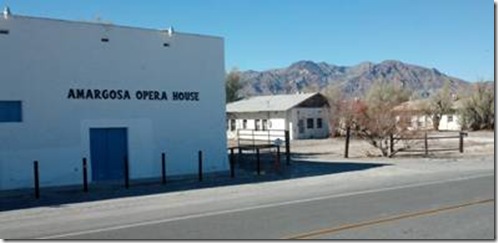
Below Death Valley is the junction where the Amargosa Opera House still stands. Operated for 40 years by the <somewhat> famous Marta Beckett, the live performances are sadly at an end after the old gal broke her hip a few years ago. I was fortunate to see one of her last active presentations, and it was quite a treat.
Entering Death Valley is like entering a different planet. The landforms and geology are nothing short of spectacular. Extraordinary ridges and slopes intermix with the historical human structures in the area, a constant series of contrasts.
I’d like to linger, but I know I’ll be staying for several days at Panamint, and exploring the area in Ralph. So I grab a few quick pix and motor on.
At Furnace Creek (with its temperature/elevation placard and gas priced at $5.24 for a gallon of 87-octane!!!), SR190 winds around to the north, and then loops all the way back southwest-bound to ascend the Panamint Range. This is the place I’ve been dreading. The road climbs and winds up almost 10 miles of grades exceeding 9-10% (that’s 500 feet of climb in a mile), and then drops as precipitously down the other side for an equal length of torturous traveling.
On the uphill portion, the engine must work at 5 times its normal load, hauling almost 18,000 pounds (nine tons) of Howie and Ralph up the grade. As importantly, the automatic transmission labors in various gears, churning its fluid in a frenzy to transmit all that increased engine power to the drive-train and the rear wheels.
The engine’s thermal health is indicated by the water temperature, and because it is a pressurized system, the water temp can get well over 212F without boiling. But 220-230 is generally considered an upper limit before wear and even breakdown start to loom. For the transmission, fluid temperatures over 250F result in 10X the wear and reduction in life. Temperatures approaching 300F can result in slippage and immediate breakdown, which is just as catastrophic and expensive as an engine failure.
As I churn up the SR190 climb, the engine temp is incredibly well-behaved, and for the entire climb it never tops 210F. Wow, what a great cooling system. The transmission, on the other hand, is giving me a heart attack. The numbers on my digital display are rocketing upward like the wheels on a slot machine, and I’m watching it ratchet quickly past 220F before I’m halfway up the hill.
Meanwhile, Howie’s 500horsepower 8.1L V8 is working like it’s never worked before. Even at 4000 RPM and full throttle, running in first-gear overdrive, the Howie-Ralph combo is able to make only about 35mph up the last, steep grade. At the top, Howie’s transmission tops out at 253F – – but this lasts for only a few minutes and should not be a real issue with transmission longevity.
So much for the worrisome part of the trip – – now we get to the scary stuff.
Brake fade is the phenomenon where the brake lining material begins to melt. Instead of friction, only lubrication occurs. When you push on a brake pedal when the brakes are faded, it actually feels like you are accelerating. This is totally NOT something that is acceptable on a 10-mile downgrade with 9 tons of metal headed for the next valley.
Just to be safe, I drop Howie all the way down into first gear, and let the speed gradually build up. Good decision. Even in this amazingly draggy gear, Howie and Ralph quickly blast up through 40mph, and Howie’s engine buzzes up past 4000rpm, headed for the 4500rpm redline. Brakes, brakes. Both Howie’s and Ralph’s brakes slow us back to 30mph. But when I release Howie’s brake, Ralph’s deceleration-activated braking stays active. This may burn out Ralph’s brakes before we reach the bottom – – but I have no choice.
For nine LONG miles I nurse the pair of lead-butt vehicles down that hill, alternating between heating-up braking action and howling 4000rpm engine braking. It’s a bit nerve-wracking, and I vow to think twice before I attempt this again. I double-vow to slit my own wrists before I ever do such a thing in hot weather. It’s only 70F outside; it’s unimaginable how vehicles tolerate this kind of roadway in the 120F summer heat – – but they do.
Everything is still working at the bottom, and we roll uneventfully the last few miles into Panamint Springs. What a relief.
Panamint Springs Resort
Arriving at Panamint, and soon thereafter meeting up with my friend Tim Cassell (whose family owns and runs the resort), I find myself with LOTS of things to do besides writing. Four days go by, enjoying and exploring the area, and I have barely scratched the surface.
First, there’s just the beautiful, huge space here. The Resort is perched at the western edge of Panamint Valley, with some of the most striking geology in the area on display across the playa. Then, there’s the Resort itself, with motel rooms, restaurant, tent and RV sites (and even a couple of tent cabins), a store and gas station (Ha!, I’ll see your Death Valley rate of $5.24 and raise you 74c to $5.98!!). The most fascinating thing for me has been to watch the Cassell family take the Resort from a somewhat shabby, failing business to a going concern that I’d recommend to anyone, all with straightforward grit, determination, and family stick-together. It’s just purely admirable. I can hardly wait, with each visit here, to find out what’s going on – – trials and tribulations – – when I talk to Tim.
The Resort has been here, through several owners, since 1937, and was rescued from certain oblivion by the Cassells in 2006. Among other noteworthy features, Ben, the general manager, hosts a microbrew beer collection in excess of 150 different beers, even including a gluten-free brew or two!
Besides the Resort, there is the great diversity of the desert area, Panamint Valley, and the nearby Saline Valley and Death Valley. Running east-to-west across the valleys is the lonely, challenging SR190, a road as demonic as the land it travels through. In fact, to get here from Las Vegas, I had to choose between a flat route (through Trona) of 350 miles, or the mountainous route (through Death Valley) of 180 miles. SR190 was certainly a handful coming over Towne Pass, but I don’t know that I’d add 170 miles to get around it.
First order of the day is to sit back and enjoy my surrounds. A cup of coffee in front of Howie, at the edge of my campsite and the camp proper, shows off the distant Panamints with their colorful bands. This view is shared by the veranda at the Resort restaurant as well
A standard weekday morning air show is hosted by the nearby military operations. Tim once ran into the squadron commander during a visit to Ridgecrest, and expressed his delight with the lowest, loudest fly-by that the squadron was willing to execute. The following day a couple of jets buzzed the Resort in true shock-attack simulation, and all were enthralled. They’re just too fast to get a good close-up unless you just happen to be standing there with a camera in your hand…. I wasn’t. They travel one mile in 6 seconds.
For a couple of strenuous days, I traveled about the desert from late morning to late afternoon or early evening. Weathered, beaten signs warn of dire consequences to all those who venture forth. Although it’s risky to travel so remotely alone and with one vehicle, I have no choice other than not to go at all.
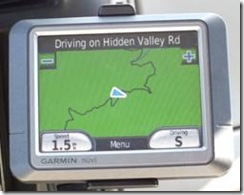 One route takes me over the Saline Valley road, across the southern pass into the northern Death Valley area and into the famous Racetrack.The road over this mountain pass is solid and passable, but extremely rough, traveling through incredibly
One route takes me over the Saline Valley road, across the southern pass into the northern Death Valley area and into the famous Racetrack.The road over this mountain pass is solid and passable, but extremely rough, traveling through incredibly 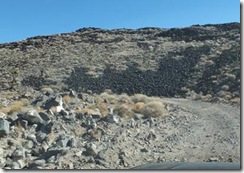 harsh terrain. It twists and turns so sharply that only the most nimble vehicles can comfortably negotiate it.
harsh terrain. It twists and turns so sharply that only the most nimble vehicles can comfortably negotiate it.
On the far side of the pass, the road becomes much more gentle, but for the amazing harshness and duration of the washboard. It’s not obvious if they grade this passage more than once a century. When it’s long and straight, I kick Ralph up to 50mph and we vibratingly dance across the top of the washboard. But if there are turns or truly rough spots (especially sharp tire-eating rocks), then we have to crawl and lurch our way through.
My reward is ample: the Racetrack is truly a sight to behold. The famous traveling rocks do indeed travel, in a wide variety of paths, sometimes even curving back or reversing course in the same track.
The light is terribly poor, a high overcast having moved in. I snap some shots anyway, more for a record than artistic content.
My brother- and sister-in-law traveled to the Racetrack a few seasons ago, in winter, on a small dirt motorcycle. The road is 27 miles of butt-pounding washboard and rocky sections, in each direction, and I now marvel at their hardiness (fool-hardiness?). Like me, they have since switched to 4 wheels for exploration. Small wonder.
The common wisdom about the moving rocks is that the silty playa surface gets slick in the occasional rain (less than 2” per year), and prevailing winds scoot the rocks along their way. Of course, we all REALLY know that the space-aliens who are held secretly in nearby Area 51 occasionally break out and come over to the racetrack to move the rocks using their brain-waves. (They’re supposed to be so smart, those aliens, but they keep fooling around and getting re-captured.)
A sad commentary on the small number of misfits among us – – vandals, idiots, and general cretins have defaced the western side of the Racetrack playa. Rocks have been stolen, vehicles driven on the playa in total disobedience of the posted signage (not to mention common sense), and rocks have even been “frauded” into place along obvious vehicle tracks. There really is no proper English word to describe these vermin, so from here on out, I will refer to them as Shiffers (as in “shiffer brains”, which seem appropriate).
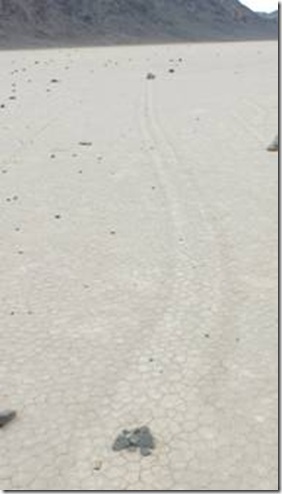 I took a long walk over to the eastern side, where the vandals seem to have lost interest, and found the birthing place of the rocks, a steep talus slope. There are probably 50-60 real rock tracks over there, and they are truly amazing in diversity, criss-crossing each other and swooping around in giant curls.
I took a long walk over to the eastern side, where the vandals seem to have lost interest, and found the birthing place of the rocks, a steep talus slope. There are probably 50-60 real rock tracks over there, and they are truly amazing in diversity, criss-crossing each other and swooping around in giant curls.
One of them seems even to have left some little rock-turds behind in its passage.
Those aliens, what jokers.
One day I spend wandering around south of the Resort, on the western and then eastern reaches of the lower Panamint Valley. This area is a mix of old mining roads, National Park, and just big, big desert.
As I roll along Padeau Road (slowly and carefully), a wild burro “anointing” spot catches my eye. Both burros and horses use their droppings to mark territory; these are obviously burros from the hoof print size, and also the dung size. Horse dung is about the size of small apples – – burros, more like plums.
Later down the road, the responsible band of burros looks up from a resting spot about 100 yards away. They seem to feel that’s a safe distance (although they’re commonly shot at by Shiffers). They don’t come any closer, and they don’t run away when I get out of the truck for some photos.
They pose nicely, in fact, and I burn up some megabytes for these charming critters.
Pretty cool, huh?
Over on the east side, the old charcoal kilns are an interesting side trip. These were used to create charcoal (from pinion pine) for silver smelting. What a structure to build, and they were abandoned after three years. Poor ROI, I think.
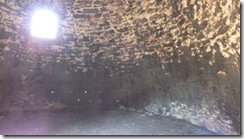 The insides are stark, the floor covered in old black ash. vents and access windows are on the back side of each kiln.
The insides are stark, the floor covered in old black ash. vents and access windows are on the back side of each kiln.
The evening weather presents a classic desert sky sunset. It’s actually a lot more impressive than the photo can tell. The wind dies off to produce a singularly still evening, and the very ground I sit on is hued a gentle orange-pink from the sky overhead. To simply sit out here, and just soak the whole thing in, is Heaven on Earth.
The next day or two is forecast to snow – – even in Death Valley!
We shall see.
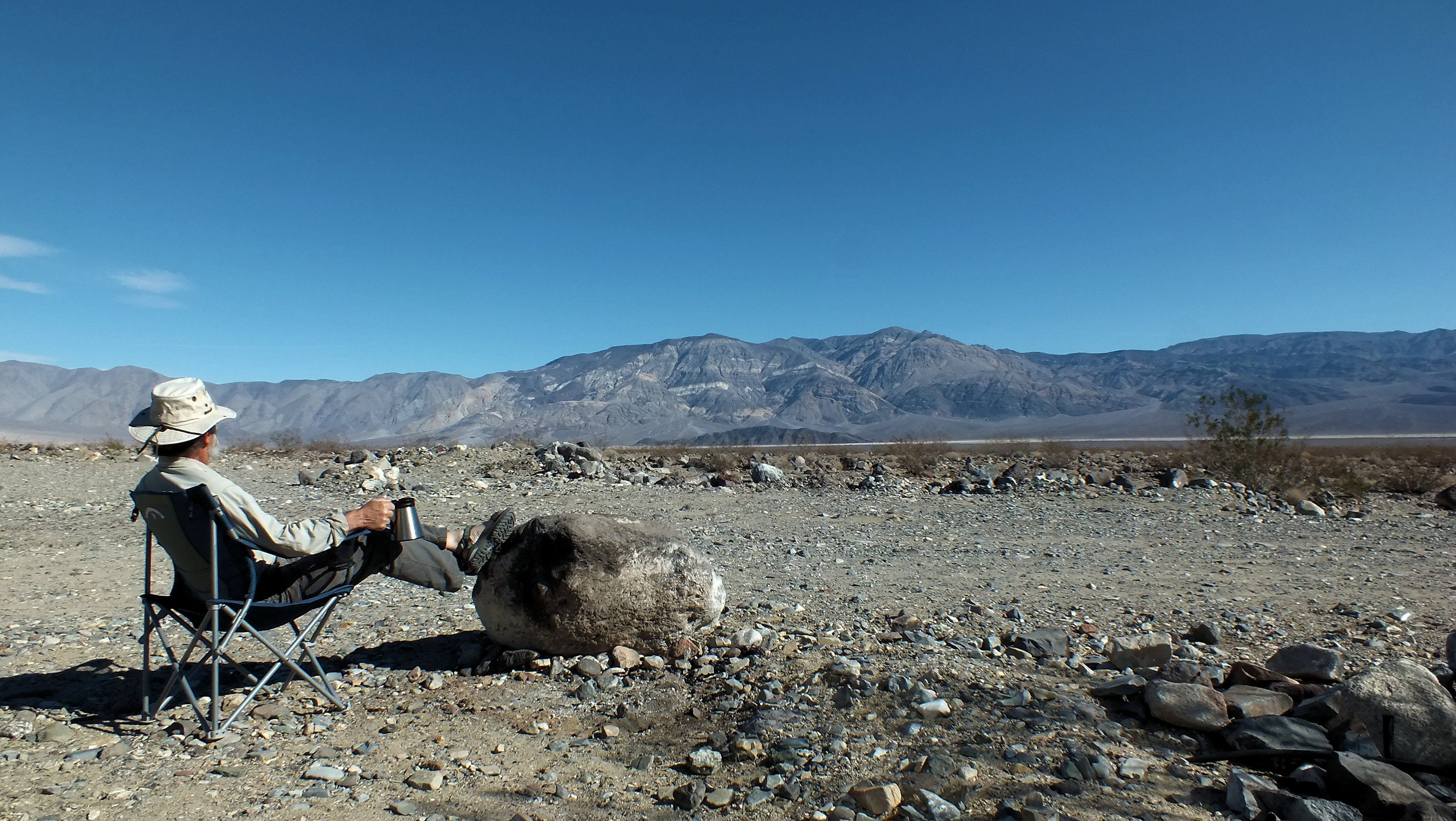

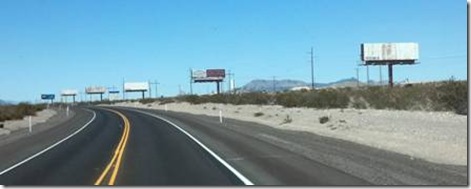


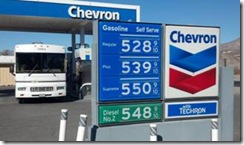

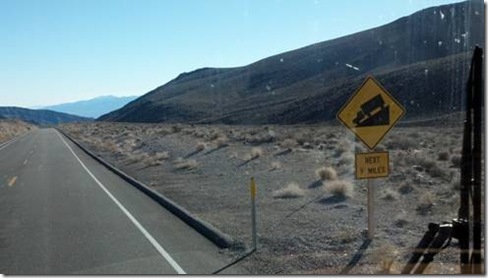
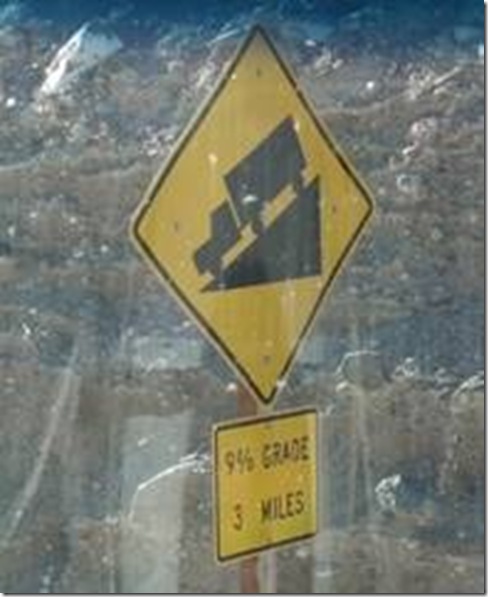
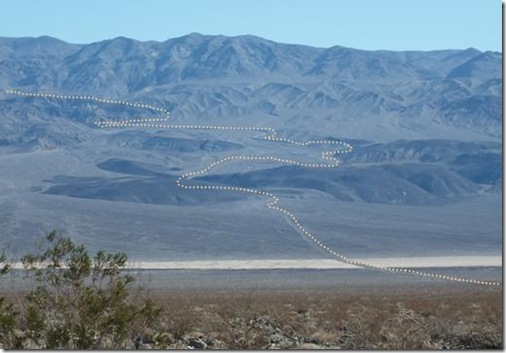
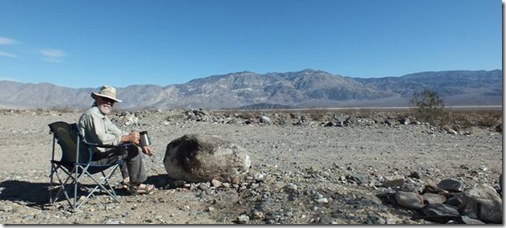
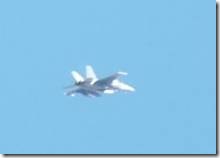
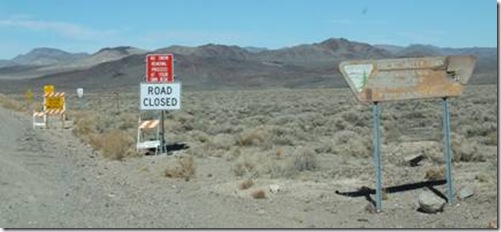
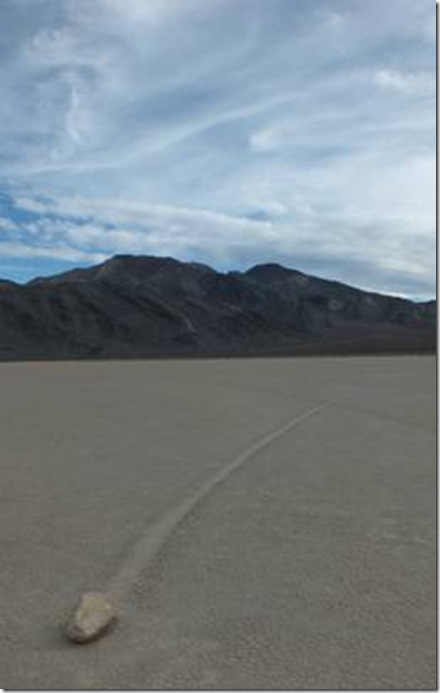
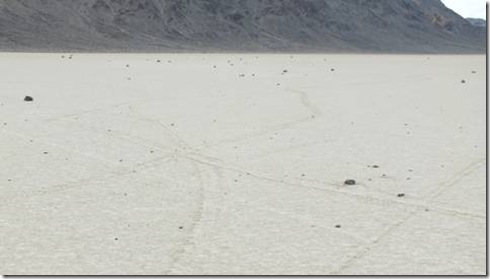
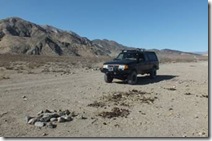
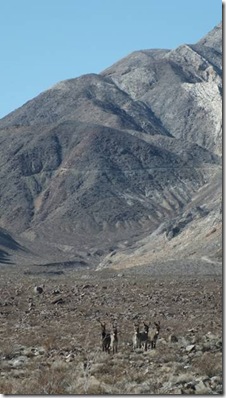


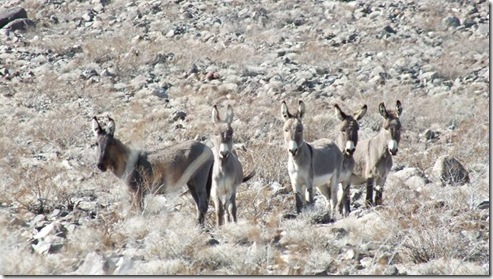


Comments
Winter 2013-14 Henderson & Panamint — No Comments
HTML tags allowed in your comment: <a href="" title=""> <abbr title=""> <acronym title=""> <b> <blockquote cite=""> <cite> <code> <del datetime=""> <em> <i> <q cite=""> <s> <strike> <strong>